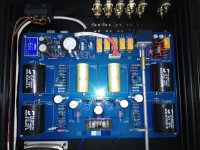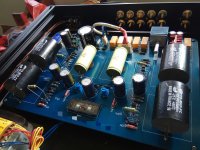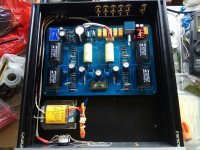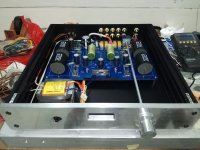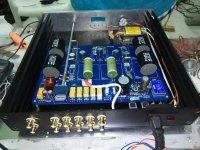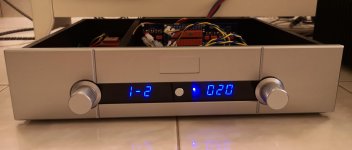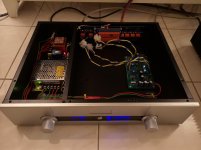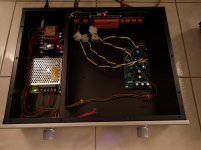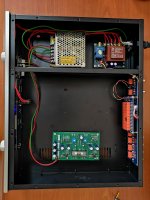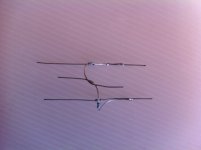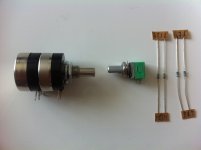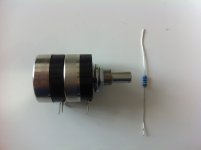My test results:
T1=24.17V
T2=23.36V
T3=21.74V
T4=8.81V
T5=0.604V
T6=0.610V
T7=9.47V
All above voltages perfectly stable.
T8...not stable... try to set to 9.5V. Falls to 9.3V. Rises to 9.8V over about a minute. Falls as low as 8.1V after 30 minutes..
Voltage at B stable at 3.454V.
Voltages across all four R1 resistors are stable. As they are positioned on the board:
R1=1.183V R1=1.777V
R1=1.180V R1=1.173V
Could this be indicating a fault with my Nutube ?
T1=24.17V
T2=23.36V
T3=21.74V
T4=8.81V
T5=0.604V
T6=0.610V
T7=9.47V
All above voltages perfectly stable.
T8...not stable... try to set to 9.5V. Falls to 9.3V. Rises to 9.8V over about a minute. Falls as low as 8.1V after 30 minutes..
Voltage at B stable at 3.454V.
Voltages across all four R1 resistors are stable. As they are positioned on the board:
R1=1.183V R1=1.777V
R1=1.180V R1=1.173V
Could this be indicating a fault with my Nutube ?
just to enliven here,
almost finished my rig. circuit is according to B1 Korg DIY preamp.
pcb is 28x19cm, enough space to put fancy capacitors 😀
psu using salas v1.3 for anode, and separated cosel regulator for filament.
equipped with relay input selector, output delay circuit, and volume control.
all in one pcb. thanks to Nelson Pass and Salas for sharing this circuits.
a little bit adjustment in some resistors because im using 5v for filament
and also using 2sk117 as input output buffers.
but everything running well, voltage are very stable in measurement.
almost finished my rig. circuit is according to B1 Korg DIY preamp.
pcb is 28x19cm, enough space to put fancy capacitors 😀
psu using salas v1.3 for anode, and separated cosel regulator for filament.
equipped with relay input selector, output delay circuit, and volume control.
all in one pcb. thanks to Nelson Pass and Salas for sharing this circuits.
a little bit adjustment in some resistors because im using 5v for filament
and also using 2sk117 as input output buffers.
but everything running well, voltage are very stable in measurement.
Attachments
sources approaching Rout of 1K and more are weaklings , calling for 50KLog volume pot
sources around 600R and lower Rout, you can use 25KLog and going lower to 10KLog
so , schematic from post #1 - you can choose value of vol pot on input ....... i
I foudn the outout impedance on a Minidsp 4x10Hd. 560 ohm, so 10-25Klog. I will use 20Klog alps for simplicity.
Hi All,
Completed mine (first stage), this is from the Xmas batch. Since the chasis has got plenty of space, I am thinking of a second stage, to put the original B1 (which I have built and been using for some time) next to the B1 with Nutube in the space next to it, and put a switch between the inputs and outputs, so that I can switch between the two on the fly 😀
The sound is very warm and nice! I changed T7 & T8 to 10.0V though, coz I think 9.5V gives just a little too much of the good thing. Maybe because I have been used to the sound of the original B1. 🙂 A big thanks to Papa Pass for this wonderful gift!
Completed mine (first stage), this is from the Xmas batch. Since the chasis has got plenty of space, I am thinking of a second stage, to put the original B1 (which I have built and been using for some time) next to the B1 with Nutube in the space next to it, and put a switch between the inputs and outputs, so that I can switch between the two on the fly 😀
The sound is very warm and nice! I changed T7 & T8 to 10.0V though, coz I think 9.5V gives just a little too much of the good thing. Maybe because I have been used to the sound of the original B1. 🙂 A big thanks to Papa Pass for this wonderful gift!
Attachments
Can a cheap LED wallwart 24V@5VA (208 mA) be used safely for the B1 Triode ? I read that the draw is only 65 mA. Still waiting for parts for the Ultrabib PSU.
Pass DIY Addict
Joined 2000
Paid Member
It is likely to draw more when starting up due to the caps...
I would think a 200mA supply would be fine. My B1 Korg idles at about 70mA and will indeed draw more upon power up, but this only lasts for ~1 second and falls rapidly as the caps charge. I haven't measured the peak current draw, but I'd be surprised to see that it is much above 150mA or so. Those resistors in the power supply keep the surge under control.
I'd say use the 5VA supply and don't worry about it while you wait for your BiB parts to arrive.
Edit: looks like we were posting at the same time. 400mA is a bit of a surprise. I measured with a 100mA analog meter that spiked full on power up, but didn't stay there at all. As soon as it hit full, it immediately began to fall.
Last edited:
I meant, the other wallwart I found had 24 VDC@400 mA. I will say prayer to Papa, and hook her up tonight.
Pass DIY Addict
Joined 2000
Paid Member
Gotcha - thanks for the clarification. I'm still thinking 200mA is more than sufficient for power on surge...
Time for a follow-up, now that the B1 Korg has been running for a while and some comparative tests have been carried out…
As a starter, these are the final steps of my built, where I left it in this thread. TBH, all the wiring I wanted, admittely not mandatory (headphone output on top of cinch output, tiny 3-source selector and other bits) took me more time than assembling the Xmas board, LOL !
I used Cat 6 wires, as recommended here. I like solid wires and wanted to avoid skin effect (low section), while having very acceptable electric constants, and being cheap. I have NOT tried this again my old Cardas etc. but I see no reason why it shouldn’t fit the bill and again it was recommended by thrustfull sources here.
For the PS wires, I used French PTT cable, damn cheap and 0.6mm diameter pure solid copper, enough for the low current (few amps) and OK for 100V, so at 24V and 1A it is fine and also easy to work for DIYer.
The source selector (again kindly advised by Jim / 6L6) is as small as last time I posted and you can’t get the Cat6 wires inside the holes (too small), so that is a small challenge that requires a bit of thinking… and says a lot about Jim’s excellent skills ! As very often, a 3rd hand or board support wasn’t that great due to the fragility of the wires so I used again a lot of blu tack to have a 3rd and 4th hand. I started with the output lugs in the middle, bending the Cat6 wires to have something like a hook to go fishing… between the other lugs. Selector was hold verticaly, and then horizontaly for the other lugs that were not easy so you want to think in which order you want to go to have a good access with the soldering iron. It looks quite impossible, but it is in fact very doable (I did dit). Only downside if you use these wires and selector like me for many tests with bending and carrying and putting in and out of a box, it is somewhat to fragile and you may have to resolder 1 or 2 wires (I had to at least)… or learn to be very careful.
What else to mention ? Oh, the Korg is really tiny ! Somewhere in my mind I had the beautifull HD pix from this thread, taken very close, and TUBE sounded big in my head… here is a not so nice pix but that put a size to this Nutube… it IS small and nice J
I used the silicone toe protection under it to absorb the vibrations that materialise indeed as ringing. Ringing in open air is no issue, might be in a box (as making sure I have no ground loops then with all these yet open connections). TBH, it still rings when switching off (remember, no box yet) and when tapping directly with the finger on the board, but it doesn’t ring when tapping hard on the support the board was on. May have, or not, to work on it.
I used the PS I mentioned last time and got, on my perhaps a bit pessimistic and cheap multimeter, the following voltages :
T1 = 23.7V
T3 = 22.4V
T4 = 8.9V
T5 = 0.637V
T6= 0.644V
Quite acceptable I believe, despite T3 a tad lowish but then we started lowish…
This values were stables quite fast and remained so during 30 min… and were measured 3 times after switching on and off.
I adjusted T7 to 9,52V and T8 to 9.50V, best I could do, dead stable so far. I haven’t played with this yet, nor have I included the B1 KORG in my system to hear how great it sounds, as I wanted first to do some small tweaks. It will later come in a Tin Delacre cake box as temporarly measure as at the end it should come into a nice casing with a RIAA pre and possibly a DAC. But that’s another sory… Suffice to say T7 and T8 will be adjusted to my liking depending on how much voltage I need at the output to get the right harmonic spectrum, and despite not having put this pre in my reference set up I can already say it sounds GREAT with these default values and highish « positive » 2nd harmonic, nice while also transparent/revealing… it has the right musicality while not being to euphonic, something I was afraid of before reading the posts here. It is a keeper already.
So why trying to moddify it ? because I promised I would report J
Oh, and on these older pix there an inversion regarding the wiring of the potentiometer, with a strange resistor…
As a starter, these are the final steps of my built, where I left it in this thread. TBH, all the wiring I wanted, admittely not mandatory (headphone output on top of cinch output, tiny 3-source selector and other bits) took me more time than assembling the Xmas board, LOL !
I used Cat 6 wires, as recommended here. I like solid wires and wanted to avoid skin effect (low section), while having very acceptable electric constants, and being cheap. I have NOT tried this again my old Cardas etc. but I see no reason why it shouldn’t fit the bill and again it was recommended by thrustfull sources here.
For the PS wires, I used French PTT cable, damn cheap and 0.6mm diameter pure solid copper, enough for the low current (few amps) and OK for 100V, so at 24V and 1A it is fine and also easy to work for DIYer.
The source selector (again kindly advised by Jim / 6L6) is as small as last time I posted and you can’t get the Cat6 wires inside the holes (too small), so that is a small challenge that requires a bit of thinking… and says a lot about Jim’s excellent skills ! As very often, a 3rd hand or board support wasn’t that great due to the fragility of the wires so I used again a lot of blu tack to have a 3rd and 4th hand. I started with the output lugs in the middle, bending the Cat6 wires to have something like a hook to go fishing… between the other lugs. Selector was hold verticaly, and then horizontaly for the other lugs that were not easy so you want to think in which order you want to go to have a good access with the soldering iron. It looks quite impossible, but it is in fact very doable (I did dit). Only downside if you use these wires and selector like me for many tests with bending and carrying and putting in and out of a box, it is somewhat to fragile and you may have to resolder 1 or 2 wires (I had to at least)… or learn to be very careful.
What else to mention ? Oh, the Korg is really tiny ! Somewhere in my mind I had the beautifull HD pix from this thread, taken very close, and TUBE sounded big in my head… here is a not so nice pix but that put a size to this Nutube… it IS small and nice J
I used the silicone toe protection under it to absorb the vibrations that materialise indeed as ringing. Ringing in open air is no issue, might be in a box (as making sure I have no ground loops then with all these yet open connections). TBH, it still rings when switching off (remember, no box yet) and when tapping directly with the finger on the board, but it doesn’t ring when tapping hard on the support the board was on. May have, or not, to work on it.
I used the PS I mentioned last time and got, on my perhaps a bit pessimistic and cheap multimeter, the following voltages :
T1 = 23.7V
T3 = 22.4V
T4 = 8.9V
T5 = 0.637V
T6= 0.644V
Quite acceptable I believe, despite T3 a tad lowish but then we started lowish…
This values were stables quite fast and remained so during 30 min… and were measured 3 times after switching on and off.
I adjusted T7 to 9,52V and T8 to 9.50V, best I could do, dead stable so far. I haven’t played with this yet, nor have I included the B1 KORG in my system to hear how great it sounds, as I wanted first to do some small tweaks. It will later come in a Tin Delacre cake box as temporarly measure as at the end it should come into a nice casing with a RIAA pre and possibly a DAC. But that’s another sory… Suffice to say T7 and T8 will be adjusted to my liking depending on how much voltage I need at the output to get the right harmonic spectrum, and despite not having put this pre in my reference set up I can already say it sounds GREAT with these default values and highish « positive » 2nd harmonic, nice while also transparent/revealing… it has the right musicality while not being to euphonic, something I was afraid of before reading the posts here. It is a keeper already.
So why trying to moddify it ? because I promised I would report J
Oh, and on these older pix there an inversion regarding the wiring of the potentiometer, with a strange resistor…
Attachments
-
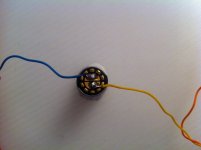 photo 54.JPG494.5 KB · Views: 283
photo 54.JPG494.5 KB · Views: 283 -
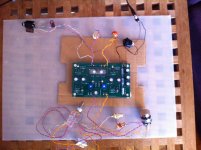 photo 44.JPG567 KB · Views: 284
photo 44.JPG567 KB · Views: 284 -
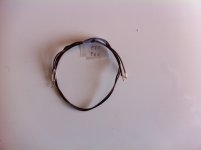 photo 43.JPG358.4 KB · Views: 256
photo 43.JPG358.4 KB · Views: 256 -
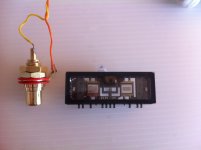 photo 33.JPG351.2 KB · Views: 334
photo 33.JPG351.2 KB · Views: 334 -
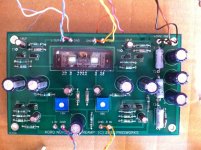 photo 55.JPG603.8 KB · Views: 350
photo 55.JPG603.8 KB · Views: 350 -
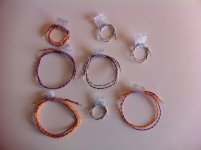 photo 11.JPG417.3 KB · Views: 682
photo 11.JPG417.3 KB · Views: 682 -
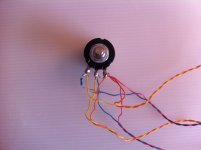 photo 5.JPG368.8 KB · Views: 674
photo 5.JPG368.8 KB · Views: 674 -
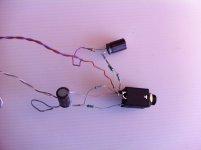 photo 3.JPG347.1 KB · Views: 674
photo 3.JPG347.1 KB · Views: 674 -
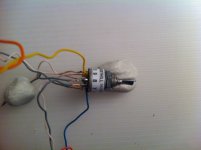 photo 2.JPG449.5 KB · Views: 683
photo 2.JPG449.5 KB · Views: 683 -
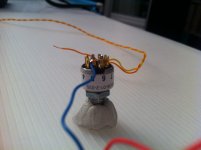 photo 1.JPG459.4 KB · Views: 688
photo 1.JPG459.4 KB · Views: 688
So I promised I would try 3 mods :
- Power supply
- Volume control
- PPP caps in signal path
Let’s report on the first mod. Initialy, I wanted to upgrade all the electrolytic caps, going for higher values as Papa said we could, but also bypassing with smaller PPP caps as I did successfully 2 decades ago on AB amp’s PS. Yes, that was the plan… as I had in fact no clue on how the B1 KORG worked, LOL ! Well, I am not much wiser TBH, sadly not my best competence field, but thanks to many posters here starting with again Jim / 6L6 and a very kind ZM / Zen Mod, I understood that my initial plan... was not wise.
There are caps that are possibly best left alone (at least I steared clear) as they are possibly very carefully chosen to impact the sonic balance of this preamp. Did my home work on emitter-follower, oscillation, bass transmission and decided that all big electrolytic caps are best left alone as recommended by Papa bare perhaps the 3 PS / Pi-filteringcaps. These PS caps don’t need bypassing as the last thing you want is bringing unwanted PS HF resonnances- you want all HF response out and voltage as stable as possible, while having a good ESR within the audio range.
So I tackled it 2 ways. First by chosing my wall wart Meanwell PS with advertised 40% less ripple than the usual already good suspects, so getting rid of as much trouble as possible at the source. Spoiler, the one I posted about last time cops with the extra current surge at start up, at least so far in my set up. Second I decided to simply swap the 3 1000uF PS caps in the PS filter with equivalent high quality 3 2200uF ones and see how it would go. Oh, the footprint wass already there on the board, nice 🙂
Don’t ask me for an ABX test as soldering the caps out took a bit of time as I didn’t know how much abuse the board could take. Once all done, allowing a few minutes of running, I tried to compare the sound of the moded board with the reference one from memory, but then I had done some careful listening for some weeks.
I must confess, the differences are tiny, in a magnitude of replacing no name electolytic caps with quality ones. Yes, I believe there is a difference, but this is where diminishing returns start as the 1000uF recommended by Papa are perfectly suited – how could it not be the case? This is what I noted for the 2200uF caps :
- no coloration, no downside whatsoever sonicaly and PS seems to cope with exra rush
- bass impulses seem sharper and stronger, quicker, easier (more torque if engine)
- clearly recording echoes and reverbs are less hidden in background noise, more very low level resolution
- perhaps a tad cleaner ( ?) but not dryer, could be my mind though
- nothing else!
All in all not a 'big' difference, but a fine one. On the other side this tweak cost only a few bucks, so good VFM ! What does that mean ? IMHO, for those that already went 1000uF or want to keep it original, no brainer, just stick to it, nothing wrong with that and possibly better things to address first. For those that have not yet built the B1 KORG, and they should do so quickly because it is trully an amazing nice resolving and sounding little pre, you could go directly for 3 2200 uF caps providing your PS can cope with the ‘small’ extra surge when powering up.
Usualy, I would want to try more of the same, to see where it ends. Here, I won't: doubling the capacity yelded a small but nice benefit, but I am pretty sure that a massively bigger PS wouldn't make any more real difference.
Just my 2ps, so for me the bigger caps stay as no downside and possibly some gain
Claude
- Power supply
- Volume control
- PPP caps in signal path
Let’s report on the first mod. Initialy, I wanted to upgrade all the electrolytic caps, going for higher values as Papa said we could, but also bypassing with smaller PPP caps as I did successfully 2 decades ago on AB amp’s PS. Yes, that was the plan… as I had in fact no clue on how the B1 KORG worked, LOL ! Well, I am not much wiser TBH, sadly not my best competence field, but thanks to many posters here starting with again Jim / 6L6 and a very kind ZM / Zen Mod, I understood that my initial plan... was not wise.
There are caps that are possibly best left alone (at least I steared clear) as they are possibly very carefully chosen to impact the sonic balance of this preamp. Did my home work on emitter-follower, oscillation, bass transmission and decided that all big electrolytic caps are best left alone as recommended by Papa bare perhaps the 3 PS / Pi-filteringcaps. These PS caps don’t need bypassing as the last thing you want is bringing unwanted PS HF resonnances- you want all HF response out and voltage as stable as possible, while having a good ESR within the audio range.
So I tackled it 2 ways. First by chosing my wall wart Meanwell PS with advertised 40% less ripple than the usual already good suspects, so getting rid of as much trouble as possible at the source. Spoiler, the one I posted about last time cops with the extra current surge at start up, at least so far in my set up. Second I decided to simply swap the 3 1000uF PS caps in the PS filter with equivalent high quality 3 2200uF ones and see how it would go. Oh, the footprint wass already there on the board, nice 🙂
Don’t ask me for an ABX test as soldering the caps out took a bit of time as I didn’t know how much abuse the board could take. Once all done, allowing a few minutes of running, I tried to compare the sound of the moded board with the reference one from memory, but then I had done some careful listening for some weeks.
I must confess, the differences are tiny, in a magnitude of replacing no name electolytic caps with quality ones. Yes, I believe there is a difference, but this is where diminishing returns start as the 1000uF recommended by Papa are perfectly suited – how could it not be the case? This is what I noted for the 2200uF caps :
- no coloration, no downside whatsoever sonicaly and PS seems to cope with exra rush
- bass impulses seem sharper and stronger, quicker, easier (more torque if engine)
- clearly recording echoes and reverbs are less hidden in background noise, more very low level resolution
- perhaps a tad cleaner ( ?) but not dryer, could be my mind though
- nothing else!
All in all not a 'big' difference, but a fine one. On the other side this tweak cost only a few bucks, so good VFM ! What does that mean ? IMHO, for those that already went 1000uF or want to keep it original, no brainer, just stick to it, nothing wrong with that and possibly better things to address first. For those that have not yet built the B1 KORG, and they should do so quickly because it is trully an amazing nice resolving and sounding little pre, you could go directly for 3 2200 uF caps providing your PS can cope with the ‘small’ extra surge when powering up.
Usualy, I would want to try more of the same, to see where it ends. Here, I won't: doubling the capacity yelded a small but nice benefit, but I am pretty sure that a massively bigger PS wouldn't make any more real difference.
Just my 2ps, so for me the bigger caps stay as no downside and possibly some gain
Claude
Wonderful to read your report! Thank you for sharing. your insights with the community.
😀 😀 😀
😀 😀 😀
I meant, the other wallwart I found had 24 VDC@400 mA. I will say prayer to Papa, and hook her up tonight.
Hello Rewind,
Do you really think that a better psu like the Salas shunt will give better results than the one recommended in the manual, I mean that cheap wallmart....?
I've seen experienced diyers using cheap psus on it.
As far as I understood, it does not matter here in this B1 circuit, but may be I am wrong.
I installed a nice psu, not fancy, just something I had on a drawer, but if one Bib makes some improvement here, I will install one, I ordered a few boards for my dac and will have some spares...
Cheers!
Moving on to the next test : volume control.
2 decades ago I compared quite a few of these for what became my passive pre and the winner was the Alps Black Beauty. It was clearly a step improvement from the usual blue Alps while I could not notice any difference with good DIY step attenuators back then. I must say I never regreted that choice as it is still not missing a bit in my current set up ! I also like the nearly endless continuous positions, the absence of noise when switching etc. and of course its outstanding reliability. Sadly, the Black Beauty is no more and cost a fortune « used » or « fake ». Plus I didn’t want to touch my main system so the BB stays where it is.
To find a suitable heir, I decided to compare some new potentiometers vs a normal Alps (which is just a small step below the Blue one), and mainly :
- a non expensive very small one I got as a gift (BI technology/TT, 20%),
- one I read very good and not so good things about (Tocos Cosmos), as it came... and tweaked with a resistor
- and all this versus a nearly perfect reference voltage divider.
The reference are 4 1% 50ppm resistors air wired and soldered – can’t be more straight forward. The test was not done to find out what sounds best with the B1 KORG, but what sounds as close as possible to the reference. Also, to enable direct A/B comparisons, numerous of them, a test rig with clips was used – not the highest HIFI but it proved by far resolving enough with headphone to serve that comparison purpose.
A few words regarding measurements. Of course music is all what matters here, but the engineer in me couldn’t help measuring a bit before, while having honestly no bias whatsoever then when listening was due.
2 decades ago I compared quite a few of these for what became my passive pre and the winner was the Alps Black Beauty. It was clearly a step improvement from the usual blue Alps while I could not notice any difference with good DIY step attenuators back then. I must say I never regreted that choice as it is still not missing a bit in my current set up ! I also like the nearly endless continuous positions, the absence of noise when switching etc. and of course its outstanding reliability. Sadly, the Black Beauty is no more and cost a fortune « used » or « fake ». Plus I didn’t want to touch my main system so the BB stays where it is.
To find a suitable heir, I decided to compare some new potentiometers vs a normal Alps (which is just a small step below the Blue one), and mainly :
- a non expensive very small one I got as a gift (BI technology/TT, 20%),
- one I read very good and not so good things about (Tocos Cosmos), as it came... and tweaked with a resistor
- and all this versus a nearly perfect reference voltage divider.
The reference are 4 1% 50ppm resistors air wired and soldered – can’t be more straight forward. The test was not done to find out what sounds best with the B1 KORG, but what sounds as close as possible to the reference. Also, to enable direct A/B comparisons, numerous of them, a test rig with clips was used – not the highest HIFI but it proved by far resolving enough with headphone to serve that comparison purpose.
A few words regarding measurements. Of course music is all what matters here, but the engineer in me couldn’t help measuring a bit before, while having honestly no bias whatsoever then when listening was due.
Attachments
Pass DIY Addict
Joined 2000
Paid Member
The small pot measured strangely : very bad and extremly good for a ‘usual’ 20% tolerance part. I did over 100 measurements, and this is what I found out on my unit (that came with a nice small and handy board) :
- miserable low level channel accuracy up to 2k / 8 O’Clock (taking also in account total resistance and comparing the ratios as one should), with anything from +88% to -9% variations, admittely often in the 15-20% range
- around 3% channel mismatch up to 9h45
- LESS than +-1% mismatch up to 27k and around +2% thereafter till full volume
- Lowish 60k channel separation Rin / Lout and vice-versa
So on the paper this device is not really suitable below 10 O’Clock position… but extremly recommendable thereafter… with some odd channel separation measurements.
How did it sound ? At first listening, quite good, and this small nice part cost probably just a couple of bucks and is nearly sealed. It sounds like an average good potentiometer that does a honest average job. Nothing seems to be missing, balance is OK, nothing wrong.
That is until you compare it to the reference or Tocos (with of course exacty the same attenuation ratio). Then I noted :
- veil over the entire spectrum
- bass and highs not so precise well defined
- poor 3D
- Poor low volume echo / reverb
- Mid bass is a bit « thicker », but quite balanced otherwise
This is a nice gift, possibly very good VFM, possibly (?) an outsider contender "after the 10' position" for the Blue Alps and again it does the job… But I want more HIFI so that one will remain a test part, a very nice and handy one for the bench.
- miserable low level channel accuracy up to 2k / 8 O’Clock (taking also in account total resistance and comparing the ratios as one should), with anything from +88% to -9% variations, admittely often in the 15-20% range
- around 3% channel mismatch up to 9h45
- LESS than +-1% mismatch up to 27k and around +2% thereafter till full volume
- Lowish 60k channel separation Rin / Lout and vice-versa
So on the paper this device is not really suitable below 10 O’Clock position… but extremly recommendable thereafter… with some odd channel separation measurements.
How did it sound ? At first listening, quite good, and this small nice part cost probably just a couple of bucks and is nearly sealed. It sounds like an average good potentiometer that does a honest average job. Nothing seems to be missing, balance is OK, nothing wrong.
That is until you compare it to the reference or Tocos (with of course exacty the same attenuation ratio). Then I noted :
- veil over the entire spectrum
- bass and highs not so precise well defined
- poor 3D
- Poor low volume echo / reverb
- Mid bass is a bit « thicker », but quite balanced otherwise
This is a nice gift, possibly very good VFM, possibly (?) an outsider contender "after the 10' position" for the Blue Alps and again it does the job… But I want more HIFI so that one will remain a test part, a very nice and handy one for the bench.
- Home
- Amplifiers
- Pass Labs
- B1 with Korg Triode
